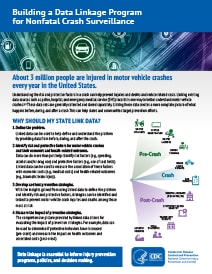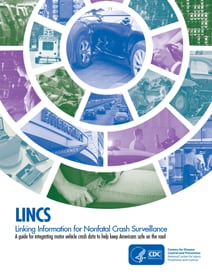Linking Information for Nonfatal Crash Surveillance (LINCS)
Data linkage is linking data sets that have information from before, during, and after a crash. By linking these data, we can get a better picture of each motor vehicle crash. Different data sources have different information. Linking existing data sources, such as police, hospital, and emergency medical service (EMS) records, is one method to better understand motor vehicle crashes, injuries, and the resulting medical outcomes and costs.
Linking Information for Nonfatal Crash Surveillance (LINCS) is a guide that helps states start or expand their data linkage program. The guide explains the key components of successful linkage programs and outlines the data-linkage process.
LINCS is based on:
- Best practices and lessons learned from successful linkage programs
- Updated environmental scans for data linkage research, methods, and tools
- State data-linkage pilot efforts
Data linkage can help answer questions such as:
How many people are nonfatally injured in motor vehicle crashes? What is the severity of motor vehicle crash-related injuries?
- Linking police and medical data will ensure injuries are attributed to crashes.
What risk factors are associated with the most severe/costly injuries?
- Police crash reports include risk factor information, and medical data capture injury severity and treatment cost.
Among drivers who were nonfatally injured in a motor vehicle crash, what proportion tested positive for alcohol, marijuana, opioids, or other drugs?
- Police crash reports include information about substance use and testing; medical data include injury and medical outcome information; toxicology data provides more extensive substance use information.
Download LINCS Guide here [PDF – 142 pages] and help prevent injuries on the road!

About 3 million people are injured in motor vehicle crashes every year in the United States. Linking existing data sources such as police, hospital, and emergency medical service (EMS) records is one way to better understand the risk and protective factors in a crash. This can help states and communities target prevention efforts to prevent injuries and deaths and reduce related costs.
The data linkage fact sheet [PDF – 2 pages] explains how states can start or expand a data linkage program for nonfatal crash surveillance.
